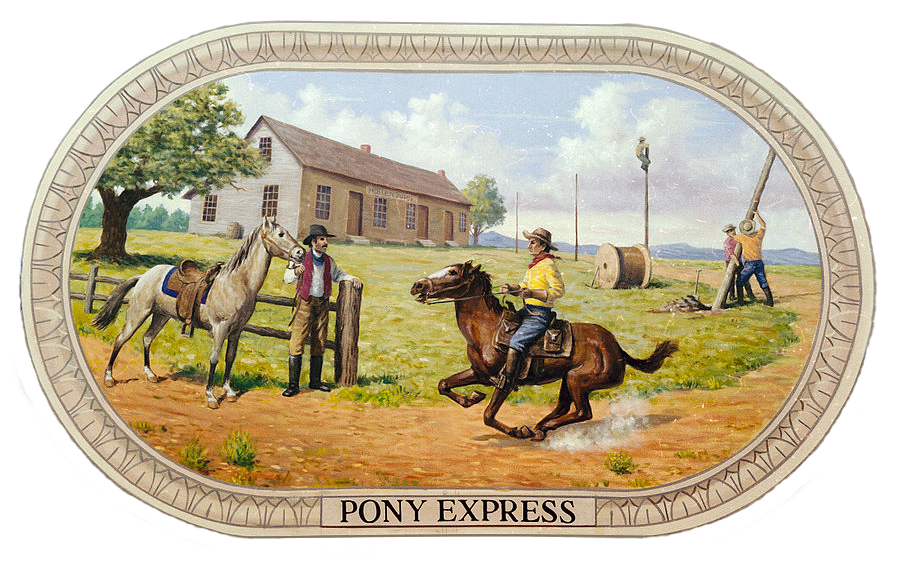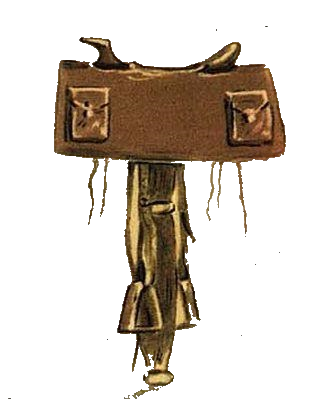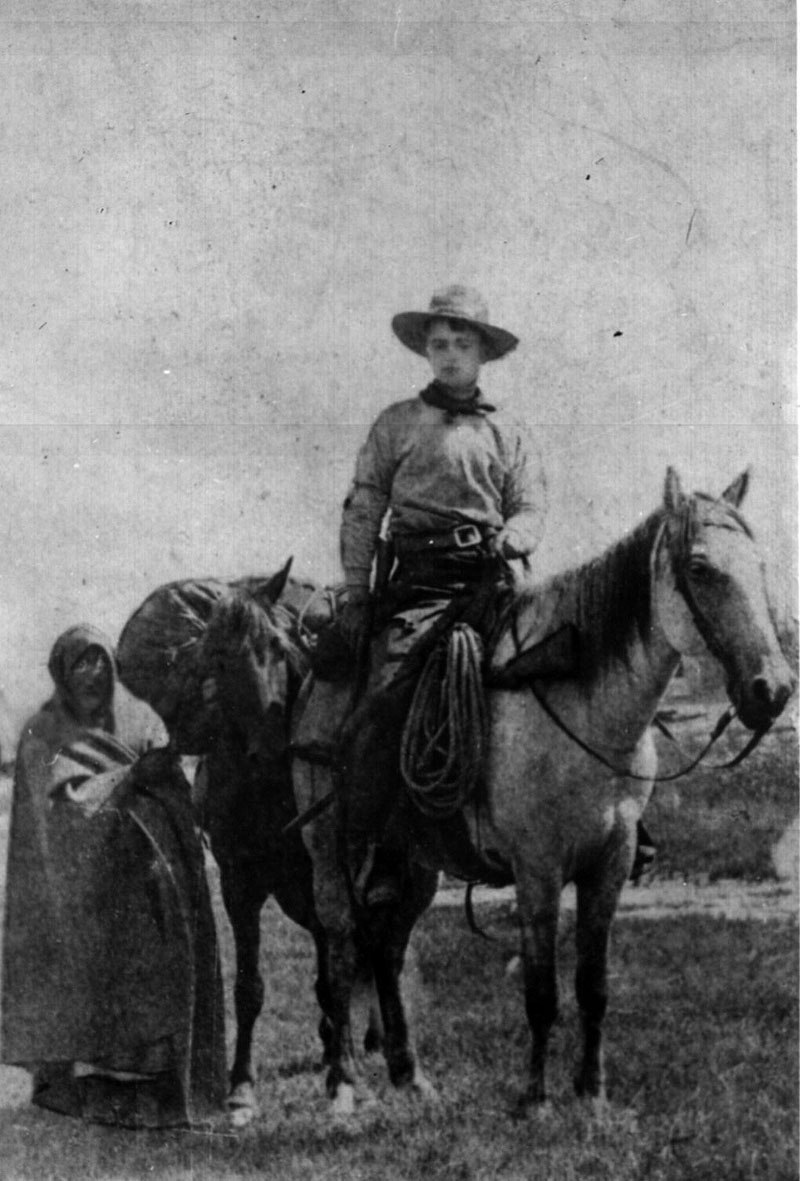Westward Expansion
Pony Express
The Pony Express was created and started in 1861 because there was a need to have a
faster way to get news and mail across the country. Mail and news delivery went from
St. Joseph, Missouri to Sacramento, California and back. It was a distance of 1,800 miles
and could be covered in 10 days. Some 400 to 500 ponies were placed at stations along
the way. At one time there were more than 100 stations. It took 80 riders to make the
trip. Only one mail delivery was ever lost. With the Pony Express, the mail got
delivered.

Certain things were required of the riders. Each rider rode about 50 miles a day and
changed horses four or five times. Riders rode the horses fast and hard, and they would
trade them out often so they could cover the distance quickly. In order to work for the
Pony Express, each new rider had to buy his own saddle. He also needed a revolver and
would have to buy that too if he did not have one already.
A large number of horses were needed to carry the riders with the news they would be
delivering. Many of the horses were mean and barely broken. Barely broken means that the ponies were pretty wild. They probably did a lot of bucking, jumping, biting, and
kicking to throw and get rid of their riders.
Cause for Headaches
Native Americans did not like the Pony Express. They would sometimes attack the riders and their stations. One time they came to the Antelope station so they could steal the horses that were there. The Pony Express riders ran after them to get the ponies back. Nick Wilson, who was one of those riders, fired three shots at them. The Indians ran into a nearby stand of cedars. Nick, following them, came around one of the cedar trees and got shot in the head by a flint-tipped arrow. The arrow hit him two inches above the left eye. When the two other boys came after him, the Indians ran away. The arrow was stuck in Nick’s head. To help their fellow rider they tried to pull the arrow out, but the arrow shaft came away, leaving the tip stuck in his head. They thought he would not make it much longer so they rolled him under one of the trees. Then they took off for the next station as fast as they could go. The next day when they returned Wilson was still alive. They carried him to a station called Cedar Wells and then went for a doctor in Ruby Valley. The doctor took the flint out and told the boys to keep a wet rag on the wound. That was all they could do.
After six days Major Egan happened to come along. Nick was still alive so the Major sent for the doctor again. When the doctor saw the rider was still alive he began to do something else. During this whole time, which was 18 days, Nick did not know what was happening because he was unconscious. To be unconscious means to be in a sleeping state, probably because of an injury. Then Wilson woke up and began getting better fast. Before long he was riding and delivering the mail again. After this shot to his head Mr. Wilson suffered from pain to his head the rest of his life.

There were many attacks from the Native Americans. One time Nick Wilson was trapped in a station with two other young boys. The army had to come and chase the Indians away.
The lives of Pony Express riders were very dangerous. Stations were being burned, riders were getting killed, and horses were being stolen. Many of the riders started to leave. It became harder and harder to get and keep riders. Because of this the Pony Express raised the pay from $40 per month to $60. Still, men did not want to take the risks.
Captured
Another time when he was an Express rider Nick Wilson was captured by the Native Americans. He was on one of his runs and they caught him and took him away. Somehow Nick's life was spared and they did not kill him. When he was a boy he had lived with the Indians for a few years and one of the braves remembered Nick. They decided to spare his life because they knew him and he promised not to ride that route again. When the braves let him go, Nick kept his promise by transferring to another area. It was 300 miles further west (Carson Sink to Fort Churchill).
For a time Nick acted as a scout and interpreter for the army. This work was done to protect the stations and riders.
Good Rider
Nick Wilson was a good horse rider and had learned at a young age how to ride and even
train horses.
 Many of his horse skills he learned while living with the Indians as a
boy. One time Spanish traders came through from California. They were selling horses. A
horse he liked was going for $60, but Nick could not buy it. A trader told him that if he
could ride it he could have it. The man did not think Nick could stay on the horse, and
he thought it would be a fun show to see Nick get thrown from the wild horse. Nick
took him up on the offer. Wouldn’t you know it, Nick stayed on the horse and got himself a
nice horse. The trader kept his word.
Many of his horse skills he learned while living with the Indians as a
boy. One time Spanish traders came through from California. They were selling horses. A
horse he liked was going for $60, but Nick could not buy it. A trader told him that if he
could ride it he could have it. The man did not think Nick could stay on the horse, and
he thought it would be a fun show to see Nick get thrown from the wild horse. Nick
took him up on the offer. Wouldn’t you know it, Nick stayed on the horse and got himself a
nice horse. The trader kept his word.
The Pony Express did not last too long. When the telegraph came it put the Express
riders out of business. The time to get a message sent went from days to seconds.

Reading resources
© Reading-SocialStudiesSolutions
Text Credits:
http://www.nps.gov/poex/learn/historyculture/index.htm;
http://ponyexpress.org/history/;
The White Indian Boy by Nicholas Wilson- Pony Express p. 39; Attack on Pony
Express by Native Americans and recovery pp. 147 and 148; Riding a horse
Image Credits:
Pony Express at the Hollenberg station2 by Architect of the U.S. Capitol through Wikimedia Commons;
Pony Express mail bag2 by William Henry Jackson - 1861- Mochilla - from Library of Congress and through Wikimedia Commons;
Pony Express rider Frank E Webner -ARC ID 513351 from Bureau of Public Roads of the National Archives Records Administration
 Many of his horse skills he learned while living with the Indians as a
boy. One time Spanish traders came through from California. They were selling horses. A
horse he liked was going for $60, but Nick could not buy it. A trader told him that if he
could ride it he could have it. The man did not think Nick could stay on the horse, and
he thought it would be a fun show to see Nick get thrown from the wild horse. Nick
took him up on the offer. Wouldn’t you know it, Nick stayed on the horse and got himself a
nice horse. The trader kept his word.
Many of his horse skills he learned while living with the Indians as a
boy. One time Spanish traders came through from California. They were selling horses. A
horse he liked was going for $60, but Nick could not buy it. A trader told him that if he
could ride it he could have it. The man did not think Nick could stay on the horse, and
he thought it would be a fun show to see Nick get thrown from the wild horse. Nick
took him up on the offer. Wouldn’t you know it, Nick stayed on the horse and got himself a
nice horse. The trader kept his word. 

